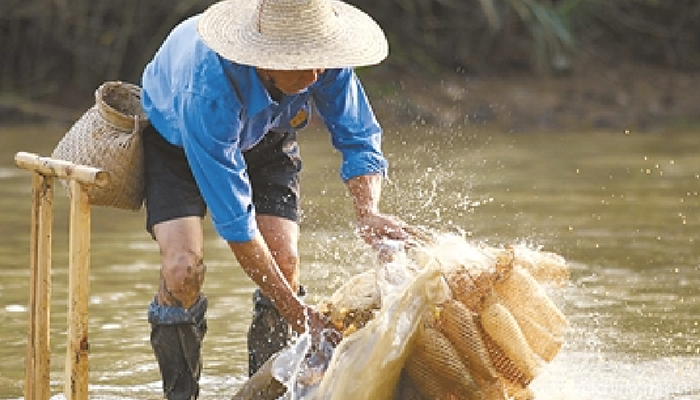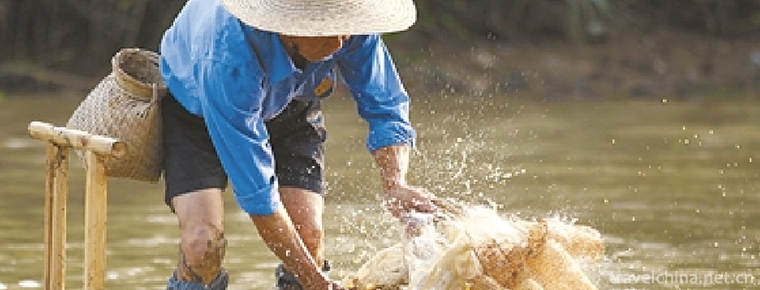Custom of mud fish
Custom of mud fish
The custom of filling mud fish is a local traditional handicraft with a long history in Guangdong Province. It combines traditional handicraft weaving and fishing skills. However, even in Doumen, the birthplace of "mud fish", fewer and fewer people know about "mud fish" now. At present, the villagers of "mud fish" in Qianwu Town are mainly middle-aged men over 40 years old, and they are facing the situation of few successors.
On May 23, 2011, the mud fish custom was approved by the State Council to be included in the third batch of national intangible cultural heritage list.
A Brief Introduction to Customs
This local traditional handicraft technique originated in the 30 years of Qianlong reign of Qing Dynasty (1765). Because of its smooth skin, mud fish often jump or crawl on shallow beaches, and it is difficult to catch it by bare hands. Villagers, according to the habit of mud fish appearing in mud caves, have worked out a way to trap mud fish in cages, while "trapping" is in Guangdong. In words, it means "trapping".
In Volume XIV of Xiangshan County Chronicle published in 1873, Tongzhi of Qing Dynasty described the unknown fish: "Ballistic drift fish is field drift fish, a flower fish and a seven-star fish. Grey and black, three or four inches long, with flowers, tender meat, delicious taste, can be used as soup. Because of their long-term activities on the beach, the surface color of the flower fish is similar to that of the sea mud, so the villagers in Hushan Village of Qianwu Town are accustomed to calling the flower fish "mud fish". The market price of mud fish is about 110 yuan/kg, which has high economic value.
According to the Propaganda Department of Doumen District, Zhuhai, the traditional custom of "filling mud fish" with a history of more than 240 years has recently been officially selected as a national intangible cultural heritage. Doumen District will protect the traditional skills that are on the verge of being lost through the establishment of an ecological protection zone for mud fish.
Custom Origin
The sun was scorching and the sea breeze was blowing. Dozens of figures wearing hats and treading mud boards swam through the offshore shoals and were cut into long and narrow silhouettes by the setting sun. The custom of "filling mud fish" originated in Qianwu Town, Doumen District, is a local traditional fishery production custom which integrates manual preparation and fishing technology. It has a very local characteristics and has been spreading for more than 200 years. This custom has been officially listed as the third national intangible cultural heritage list.
At first, it was fishing, but no suitable bait was found. Later, according to the habit of mud fish appearing in mud caves, the ancestors of Hushan Village in Qianwu Town of Doumen District made a living by "filling mud fish". They trafficked a large number of fish to Zhongshan, Jiangmen, Xinhui, Taishan and other areas, which became a very important form of trade at that time. Until the middle of the last century, 90% of the rural households in Hushan village used the income from selling mud fish as their main source of income, and often went fishing in groups. So far, the local villagers have kindly called the vast beach "mud jam ten thousand" (Cantonese dialect, meaning banks on the beach). Current status of fish cages for "mud fish". The custom of "mud fish" is on the verge of being lost.
In order to weave fish cage, not only the material selection and process are exquisite, but also the knitter should have a set of skilled manual skills. Generally, fish cages are 18-20 cm long and 8 cm in diameter. Mud fish, also known as flower fish, generally grow in the coastal area of Dongguan, Guangdong Province, while "dressing" mud fish is a unique fishing method in Dongguan, Guangdong dialect, "dressing" means "trapping". Because the skin of mud fish is very smooth, often jumping or crawling on the shoal, it is difficult to catch them by bare hands. Villagers like to catch mud fish in Dongguan. The habit of appearing in mud caves has worked out the method of trapping with cages. The special mud fish cage is equipped with an organ device, with a ring of toothed concealer, which extends inward like a funnel. When mud fish enter the cage by mistake, how cunning and clever they can not escape.
With the further acceleration of urban industrialization and the popularization of artificial breeding mud fish technology, the custom of mud fish has gradually disappeared. Zhangpeng Village staff said: "Before, many people in Zhangpeng could load mud fish, and when they were young, they also used to load mud fish with adults. Now, except Xinsha and Jiaowei two natural villages, a few of them are now carrying mud fish. The farmer who lives by fishing hardly sees villagers loading mud fish again.


-
1.Guangzhou soup
Guangzhou old fire soup is a traditional and famous dish, which belongs to Guangdong cuisine.
Time 2018-11-14 -
2.Shangqiu Ancient Culture Tourist Area
Shangqiu Ancient Culture Tourist Area is located in Suiyang District of Shangqiu City. Based on Shangqiu Ancient City, the area of 12.6 square kilometers is covered by Guidefu City
Time 2019-02-08 -
3.Wuzhizhou Island Scenic Area
Wuzhizhou Island is situated in Haitangwan Bay in the north of Sanya City. It is opposite to Monkey Island in the South and is adjacent to Yalong Bay
Time 2019-02-24 -
4.Zizhuyuan Park
Zizhuyuan Park is located in the West Third Ring of Beijing, near Baishiqiao in Haidian District, west of Beijing Capital Stadium. Zizhuyuan Park was built in 1953. It was named for the Ming and Qing
Time 2019-03-22 -
5.Bru
Bru, Mongolian means throwing. Competitions are divided into two categories: long throw and accurate throw, mostly held in festive festivals. The long throw is to decide
Time 2019-04-04 -
6.Daur traditional Hockey
Daur's traditional hockey sport is called "Bei Kuo Taj Ke Bei" in Daur language. Bei Kuo refers to a bat. The Daur bat is made by grinding oak wood with curved roots and straight branches. I
Time 2019-04-22 -
7.Gell
"Gar", which means singing and dancing in Tibetan, also means "music and dance", because performing Gar has accompaniment of special instruments. On the staff roster of the Tibetan
Time 2019-04-30 -
8.Pingyao Shage Player
Pingyao Shage Opera, commonly known as Shage Renren, also referred to as Shage, is one of the traditional handicraft techniques in Pingyao, Shanxi Province. Because it was usually placed in the cabine
Time 2019-06-09 -
9.Shizhu Tujia Luoer Diao
Shizhu Tujia Luoer Diao originated from Shizhu Tujia Autonomous County, Chongqing. It is a folk song of Luoer tune, which is popular among the Han and Tujia nationalities in southeastern Chongqing. It
Time 2019-06-15 -
10.Jade carving
Jade carving is one of the oldest carving varieties in China. Jade carved into exquisite crafts, known as jade carving. Craftsmen in the production process, according to the natural color and shape of
Time 2019-07-16 -
11.Leshan economy
In 2019, Leshan's GDP will reach 186.331 billion yuan, an increase of 7.6% over the previous year in terms of comparable prices. The industrial value increased by 24.288 billion yuan, with an increase of 24.288 billion yuan in the first value, and the second
Time 2020-12-17 -
12.Plant resources in Nanchong
There is only one kind of Metasequoia glyptostroboides introduced and cultivated in Nanchong City; there are two kinds of wild protected plants, namely, fragrant fruit tree and narrow leaf pygmy grass, and two kinds of cultivated Ginkgo biloba and Eucommia
Time 2020-12-17